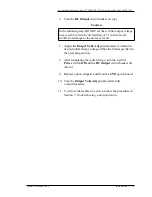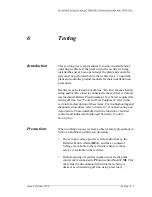
Lucent Technologies Lineage
®
2000 100A Ferroresonant Rectifier J85503A-1
6 - 2 Testing
Issue 6 October 1998
Tools and Test
Equipment
The following items are needed for testing the rectifier.
•
DMM (Digital Multimeter) Fluke 8060A or equivalent
meter having 0.02 percent accuracy on dc scale
•
Battery Plant Simulator Test Set, customer constructed, or
equivalent (see Figure 6-1)
•
DC dummy test load, 26-volt (24-volt rectifier) or 52-volt
(48-volt rectifier) with adjustment to provide a load of 120
amperes, 120 percent of the rectifier's rating
•
Jeweler's screwdriver for adjusting potentiometers
•
Straightened paper clip inserted in eraser of wooden pencil
Battery Plant
Simulator Test
Set
The Battery Plant Simulator Test Set is a convenient tool used to
isolate communication troubles between the plant controller and
the rectifier. It simulates the plant controller relative to receiving
signals from, and sending signals to, the rectifier. If there is a
problem and the rectifier works properly with the test set, the
problem is either at the controller or in the interface wiring (plant
cable). Figure 6-1 shows how to construct a test set and cable.
Test Load
Connection
The following procedures are used to connect a test load when
called for in a test or other procedure. Refer to the rectifier
control panel in Figure 2-5. Test load connections are made on
the internal bus of the rectifier. Therefore, to isolate the rectifier
from the batteries and plant bus, the rectifier DC Output circuit
breaker must be left open (off) while the test load is connected.
1. At the ac service panel, remove ac power to the rectifier.
2. Turn off (down) the rectifier DC Output circuit breaker.
3. Disconnect J2A from CM2 by unlatching first, then
pulling the cable connector.
Warning
Do not turn the DC Output circuit breaker ON, close an
external charge circuit breaker, or install an external charge
fuse until told to do so.
















































